Exploring the Key Factors Influencing Sustainable Urban Renewal from the Perspective of Multiple Stakeholders
Abstract
1. Introduction
2. Literature Review
2.1. Multiple Stakeholders of Sustainable Urban Renewal
2.2. Multiple Factors of Sustainable Urban Renewal
3. Methodology
3.1. Methods
3.1.1. Influencing Factors Identification
3.1.2. Social Network Analysis
3.1.3. Analysis Using the Reliability Interval Method

3.2. Questionnaire Survey
3.2.1. Study Area
3.2.2. Data Collection
4. Results
4.1. Indicators of Sustainable Urban Renewal Assessment
4.1.1. Results of Social Network Analysis
4.1.2. Determination of the Indicators of the Sustainable Urban Renewal Assessment
4.2. Results of Reliability Interval Method
5. Discussion
5.1. The Demand of Various Stakeholders
5.2. Impact of Sustainability Evaluation Indicators
5.3. Application of Sustainability Evaluation Indicators
6. Conclusions
Author Contributions
Funding
Institutional Review Board Statement
Informed Consent Statement
Data Availability Statement
Acknowledgments
Conflicts of Interest
References
- Chan, E.H.; Yung, E.H. Is the development control legal framework conducive to a sustainable dense urban development in Hong Kong? Habitat Int. 2004, 28, 409–426. [Google Scholar] [CrossRef]
- Zheng, H.W.; Shen, G.Q.; Wang, H. A review of recent studies on sustainable urban renewal. Habitat Int. 2014, 41, 272–279. [Google Scholar] [CrossRef]
- Ho, D.C.W.; Yau, Y.; Poon, S.W.; Liusman, E. Achieving sustainable urban renewal in Hong Kong: Strategy for dilapidation assessment of high rises. J. Urban Plan. Dev. 2012, 138, 153–165. [Google Scholar] [CrossRef]
- Bromley, R.D.; Tallon, A.R.; Thomas, C.J. City centre regeneration through residential development: Contributing to sustainability. Urban Stud. 2005, 42, 2407–2429. [Google Scholar] [CrossRef]
- Barber, A.; Pareja Eastaway, M. Leadership challenges in the inner city: Planning for sustainable regeneration in Birmingham and Barcelona. Policy Stud. 2010, 31, 393–411. [Google Scholar] [CrossRef]
- Hao, W.; Shen, Q.; Tang, B.S.; Skitmore, M. An integrated approach to supporting land-use decisions in site redevelopment for urban renewal in Hong Kong. Habitat Int. 2013, 38, 70–80. [Google Scholar]
- Waite, I.A. Power differentials in Istanbul redevelopment practices: Toward a more collaborative decision-making process. J. Plan. Educ. Res. 2023, 43, 428–437. [Google Scholar] [CrossRef]
- Wang, J.; Bai, Y.; Song, J. The Evolution, Challenges and Suggestions of Urban Renewal in China. Planners 2021, 37, 21–27. [Google Scholar]
- Zhu, S.; Li, D.; Feng, H.; Gu, T.; Zhu, J. AHP-TOPSIS-based evaluation of the relative performance of multiple neighborhood renewal projects: A case study in Nanjing, China. Sustainability 2019, 11, 4545. [Google Scholar] [CrossRef]
- Sharifi, A.; Murayama, A. Neighborhood sustainability assessment in action: Cross-evaluation of three assessment systems and their cases from the US, the UK, and Japan. Build. Environ. 2014, 72, 243–258. [Google Scholar] [CrossRef]
- Mrak, I. Locally Based Development—Tools for Identifying Opportunities and Evaluating Port Area Strategies of Rijeka. Sustainability 2013, 5, 4024–4056. [Google Scholar] [CrossRef]
- Pérez, M.G.R.; Laprise, M.; Rey, E. Fostering sustainable urban renewal at the neighborhood scale with a spatial decision support system. Sustain. Cities Soc. 2018, 38, 440–451. [Google Scholar] [CrossRef]
- Hemphill, L.; Berry, J.; McGreal, S. An indicator-based approach to measuring sustainable urban regeneration performance: Part 1, conceptual foundations and methodological framework. Urban Stud. 2004, 41, 725–755. [Google Scholar] [CrossRef]
- Hemphill, L.; McGreal, S.; Berry, J. An indicator-based approach to measuring sustainable urban regeneration performance: Part 2, empirical evaluation and case-study analysis. Urban Stud. 2004, 41, 757–772. [Google Scholar] [CrossRef]
- Couch, C.; Dennemann, A. Urban regeneration and sustainable development in Britain: The example of the Liverpool Ropewalks Partnership. Cities 2000, 17, 137–147. [Google Scholar] [CrossRef]
- BAI, Y.; LU, W.; LIU, L. Urban Renewal Planning in City Centre Based on Three-Dimensional Transport: A Case Study of Shiodome in Tokyo, Japan. City Plan. Rev. 2014, 38, 76–83. [Google Scholar]
- Liu, X.; Kong, M.; Tong, D.; Zeng, X.; Lai, Y. Property rights and adjustment for sustainable development during post-productivist transitions in China. Land Use Policy 2022, 122, 106379. [Google Scholar] [CrossRef]
- Liu, X.; Li, Z.; Fu, X.; Yin, Z.; Liu, M.; Yin, L.; Zheng, W. Monitoring House Vacancy Dynamics in The Pearl River Delta Region: A Method Based on NPP-VIIRS Night-Time Light Remote Sensing Images. Land 2023, 12, 831. [Google Scholar] [CrossRef]
- Zhou, T.; Zhou, Y. Fuzzy comprehensive evaluation of urban regeneration decision-making based on entropy weight method: Case study of yuzhong peninsula, China. J. Intell. Fuzzy Syst. 2015, 29, 2661–2668. [Google Scholar] [CrossRef]
- Brooks, A.; Rich, H. Sustainable construction and socio-technical transitions in London’s mega-projects. Geogr. J. 2016, 182, 395–405. [Google Scholar] [CrossRef]
- Rogers, C.D.; Lombardi, D.R.; Leach, J.M.; Cooper, R.F. The urban futures methodology applied to urban regeneration. In Proceedings of the Institution of Civil Engineers-Engineering Sustainability; Thomas Telford Ltd.: London, UK, 2012; pp. 5–20. [Google Scholar]
- Wang, H.; Zhao, Y.; Gao, X.; Gao, B. Collaborative decision-making for urban regeneration: A literature review and bibliometric analysis. Land Use Policy 2021, 107, 105479. [Google Scholar] [CrossRef]
- Kriese, U.; Scholz, R.W. The positioning of sustainability within residential property marketing. Urban Stud. 2011, 48, 1503–1527. [Google Scholar] [CrossRef] [PubMed]
- Greenwood, D.; Newman, P. Markets, large projects and sustainable development: Traditional and new planning in the Thames Gateway. Urban Stud. 2010, 47, 105–119. [Google Scholar] [CrossRef]
- Tong, D.; Chu, J.; Han, Q.; Liu, X. How Land Finance Drives Urban Expansion under Fiscal Pressure: Evidence from Chinese Cities. Land 2022, 11, 253. [Google Scholar] [CrossRef]
- Basarir, H.; Saifi, Y.; Hoskara, S.Ö. A debate on the top-down approach to architectural interventions in conflicted historic cities: Jerusalem’s Museum of tolerance. J. Archit. Plan. Res. 2016, 33, 235–250. [Google Scholar]
- Selim, G.; Abdelmonem, M.G.; Mushatat, S.; Almogren, A. Contested heritage: An analysis of the physical transformation of Derry/Londonderry’s siege monument. Archnet-IJAR Int. J. Archit. Res. 2017, 11, 146–162. [Google Scholar] [CrossRef]
- Bryson, J.R.; Lombardi, R. Balancing product and process sustainability against business profitability: Sustainability as a competitive strategy in the property development process. Bus. Strategy Environ. 2009, 18, 97–107. [Google Scholar] [CrossRef]
- Zewdie, M.; Worku, H.; Bantider, A. Inner city urban renewal: Assessing the sustainability and implications for urban landscape change of Addis Ababa. J. Hous. Built Environ. 2021, 36, 1249–1275. [Google Scholar] [CrossRef]
- Liu, X.; Huang, J.; Zhu, J. Property-rights regime in transition: Understanding the urban regeneration process in China–A case study of Jinhuajie, Guangzhou. Cities 2019, 90, 181–190. [Google Scholar] [CrossRef]
- Liu, G.; Fu, X.; Han, Q.; Huang, R.; Zhuang, T. Research on the collaborative governance of urban regeneration based on a Bayesian network: The case of Chongqing. Land Use Policy 2021, 109, 105640. [Google Scholar] [CrossRef]
- Ferretti, V.; Grosso, R. Designing successful urban regeneration strategies through a behavioral decision aiding approach. Cities 2019, 95, 102386. [Google Scholar] [CrossRef]
- Korkmaz, C.; Balaban, O. Sustainability of urban regeneration in Turkey: Assessing the performance of the North Ankara Urban Regeneration Project. Habitat Int. 2020, 95, 102081. [Google Scholar] [CrossRef]
- Chan, E.H.; Wang, A.; Lang, W. Comprehensive evaluation framework for sustainable land use: Case study of Hong Kong in 2000–2010. J. Urban Plan. Dev. 2016, 142, 05016007. [Google Scholar] [CrossRef]
- Yung, E.H.; Chan, E.H. Implementation challenges to the adaptive reuse of heritage buildings: Towards the goals of sustainable, low carbon cities. Habitat Int. 2012, 36, 352–361. [Google Scholar] [CrossRef]
- Laprise, M.; Lufkin, S.; Rey, E. An indicator system for the assessment of sustainability integrated into the project dynamics of regeneration of disused urban areas. Build. Environ. 2015, 86, 29–38. [Google Scholar] [CrossRef]
- Zheng, H.W.; Shen, G.Q.; Song, Y.; Sun, B.; Hong, J. Neighborhood sustainability in urban renewal: An assessment framework. Environ. Plan. B Urban Anal. City Sci. 2017, 44, 903–924. [Google Scholar] [CrossRef]
- Zheng, W.; Shen, G.Q.; Wang, H.; Hong, J.; Li, Z. Decision support for sustainable urban renewal: A multi-scale model. Land Use Policy 2017, 69, 361–371. [Google Scholar] [CrossRef]
- Yildiz, S.; Kivrak, S.; Arslan, G. Contribution of built environment design elements to the sustainability of urban renewal projects: Model proposal. J. Urban Plan. Dev. 2019, 145, 4018045. [Google Scholar] [CrossRef]
- Lin, S.-H.; Huang, X.; Fu, G.; Chen, J.-T.; Zhao, X.; Li, J.-H.; Tzeng, G.-H. Evaluating the sustainability of urban renewal projects based on a model of hybrid multiple-attribute decision-making. Land Use Policy 2021, 108, 105570. [Google Scholar] [CrossRef]
- Wellman, B. The Development of Social Network Analysis: A Study in the Sociology of Science. Contemp. Sociol. A J. Rev. 2008, 37, 221–222. [Google Scholar] [CrossRef]
- Lee, J.H.; Lim, S. An analytic hierarchy process (AHP) approach for sustainable assessment of economy-based and community-based urban regeneration: The case of South Korea. Sustainability 2018, 10, 4456. [Google Scholar]
- Bai, Y.; Song, J.; Wu, S.; Wang, W.; Lo, J.; Lo, S.M. Comparing the Impacts of Location Attributes on Residents’ Preferences and Residential Values in Compact Cities: A Case Study of Hong Kong. Sustainability 2020, 12, 4867. [Google Scholar] [CrossRef]
- Lo, S.; Hu, B.; Liu, M.; Yuen, K. On the use of reliability interval method and grey relational model for fire safety ranking of existing buildings. Fire Technol. 2005, 41, 255–270. [Google Scholar] [CrossRef]
- Lo, S.M.; Zhao, C.M.; Cheng, W.Y. Perceptions of building professionals on sustainable development: A comparative study between Hong Kong and Shenyang. Energy Build. 2006, 38, 1327–1334. [Google Scholar] [CrossRef]
- Lin, C.; Du, Y.; Yue, J.; Wang, J. A Research on the Urban Regeneration Mechanism of Multiple-Stakeholder Collaboration: A Case Study of Shenzhen. Urban Plan. Forum 2019, 253, 56–62. [Google Scholar]
- Huang, W. Response of Urban Regeneration to the Evolution of Urban Governance: A Pioneering Experiment of Shenzhen. City Plan. Rev. 2021, 45, 19–29. [Google Scholar]
- Jiang, Y.; Mohabir, N.; Ma, R.; Wu, L.; Chen, M. Whose village? Stakeholder interests in the urban renewal of Hubei old village in Shenzhen. Land Use Policy 2020, 91, 104411. [Google Scholar] [CrossRef]
- Li, B.; Tong, D.; Wu, Y.; Li, G. Government-backed ‘laundering of the grey’in upgrading urban village properties: Ningmeng apartment project in Shuiwei Village, Shenzhen, China. Prog. Plan. 2021, 146, 100436. [Google Scholar] [CrossRef]
- Gu, S.; Li, J.; Wang, M.; Ma, H. Post-Renewal Evaluation of an Urbanized Village with Cultural Resources Based on Multi Public Satisfaction: A Case Study of Nantou Ancient City in Shenzhen. Land 2023, 12, 211. [Google Scholar] [CrossRef]
- Li, S.; Qu, F. Preserving Authenticity in Urban Regeneration: A Framework for the New Definition from the Perspective of Multi-Subject Stakeholders—A Case Study of Nantou in Shenzhen, China. Int. J. Environ. Res. Public Health 2022, 19, 9135. [Google Scholar] [CrossRef] [PubMed]
- Capolongo, S.; Sdino, L.; Dell’Ovo, M.; Moioli, R.; Della Torre, S. How to assess urban regeneration proposals by considering conflicting values. Sustainability 2019, 11, 3877. [Google Scholar] [CrossRef]
- Wang, Y.; Li, J.; Zhang, G.; Li, Y.; Asare, M.H. Fuzzy evaluation of comprehensive benefit in urban renewal based on the perspective of core stakeholders. Habitat Int. 2017, 66, 163–170. [Google Scholar] [CrossRef]
- Li, D.; Du, B.; Zhu, J. Evaluating old community renewal based on emergy analysis: A case study of Nanjing. Ecol. Model. 2021, 449, 109550. [Google Scholar] [CrossRef]
- Antolín, J.; de Torre, C.; García-Fuentes, M.Á.; Pérez, A.; Tomé, I.; Mirantes, M.L.; Hoyos, E. Development of an evaluation framework for smartness and sustainability in cities. Sustainability 2020, 12, 5193. [Google Scholar] [CrossRef]
- Juan, Y.K.; Roper, K.O.; Castro-Lacouture, D.; Ha Kim, J. Optimal decision making on urban renewal projects. Manag. Decis. 2010, 48, 207–224. [Google Scholar] [CrossRef]
- Dell’Ovo, M.; Dell’Anna, F.; Simonelli, R.; Sdino, L. Enhancing the cultural heritage through adaptive reuse. A multicriteria approach to evaluate the Castello Visconteo in Cusago (Italy). Sustainability 2021, 13, 4440. [Google Scholar] [CrossRef]
- Marta, B.; Giulia, D. Addressing social sustainability in urban regeneration processes. An application of the social multi-criteria evaluation. Sustainability 2020, 12, 7579. [Google Scholar] [CrossRef]
- Kim, H.W.; Aaron McCarty, D.; Lee, J. Enhancing sustainable urban regeneration through smart technologies: An assessment of local urban regeneration strategic plans in Korea. Sustainability 2020, 12, 6868. [Google Scholar] [CrossRef]
- Turcu, C. Re-thinking sustainability indicators: Local perspectives of urban sustainability. J. Environ. Plan. Manag. 2013, 56, 695–719. [Google Scholar] [CrossRef]
- Berg, P.G.; Eriksson, T.; Granvik, M. Micro-comprehensive planning in Baltic Sea urban local areas. In Proceedings of the Institution of Civil Engineers-Engineering Sustainability; Thomas Telford Ltd.: London, UK, 2010; pp. 219–232. [Google Scholar]
- Williams, K.; Dair, C. A framework for assessing the sustainability of brownfield developments. J. Environ. Plan. Manag. 2007, 50, 23–40. [Google Scholar] [CrossRef]
- Schuetze, T.; Chelleri, L.; Je, J.-H. Measuring urban redevelopment sustainability: Exploring challenges from downtown Seoul. Sustainability 2016, 9, 40. [Google Scholar] [CrossRef]
- Liao, Y.J.; Ye, K.H.; Fu, H.Y.; Ma, L. Evaluation of Urban Regeneration Project Plans with an Integrated Model Based on Analytic Network Process. Appl. Mech. Mater. 2013, 253–255, 102–105. [Google Scholar] [CrossRef]
- Brombal, D.; Niu, Y.; Pizzol, L.; Moriggi, A.; Wang, J.; Critto, A.; Jiang, X.; Liu, B.; Marcomini, A. A participatory sustainability assessment for integrated watershed management in urban China. Environ. Sci. Policy 2018, 85, 54–63. [Google Scholar] [CrossRef]
- Liu, X.; Tong, D.; Huang, J.; Zheng, W.; Kong, M.; Zhou, G. What matters in the e-commerce era? Modelling and mapping shop rents in Guangzhou, China. Land Use Policy 2022, 123, 106430. [Google Scholar] [CrossRef]
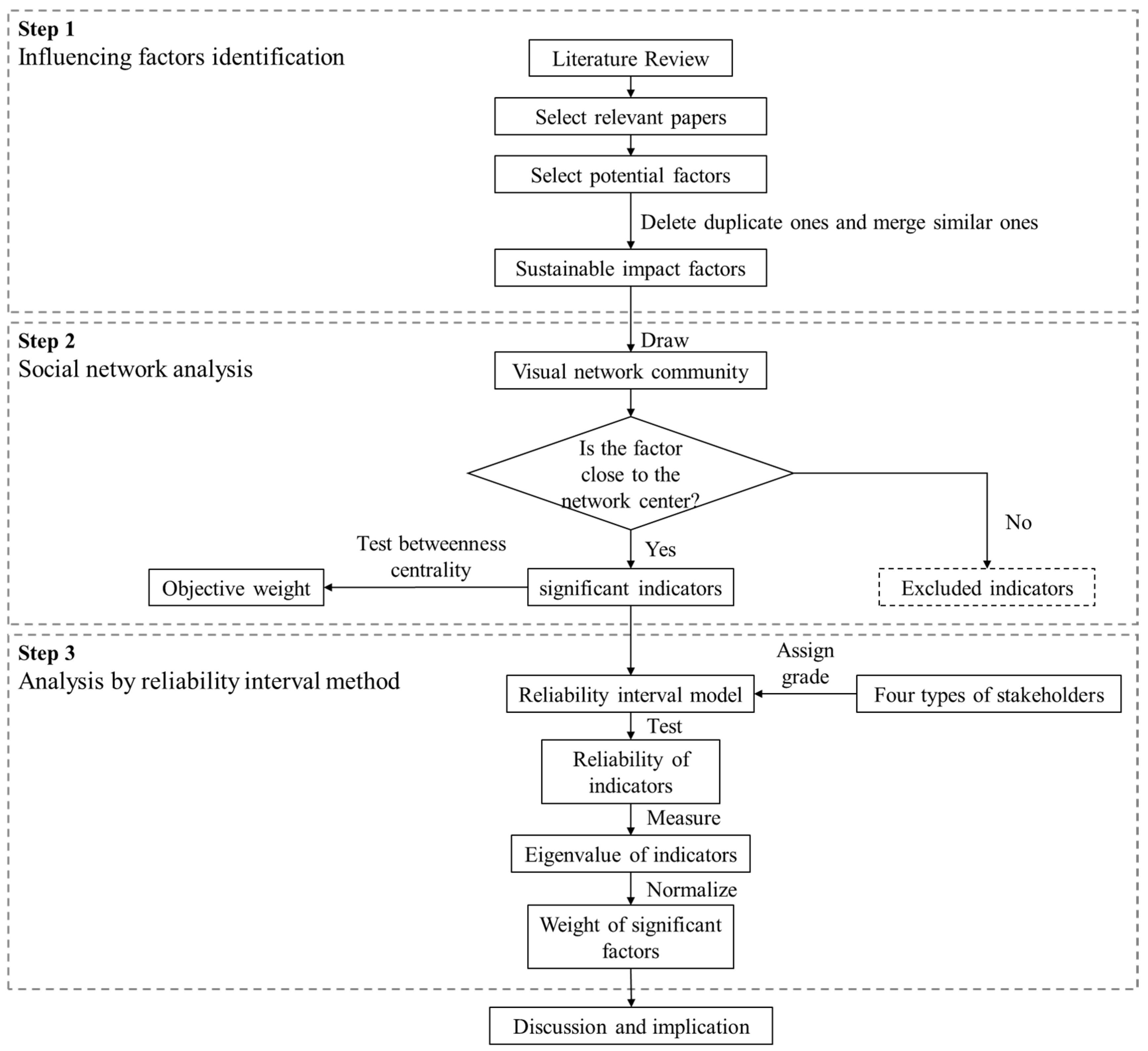
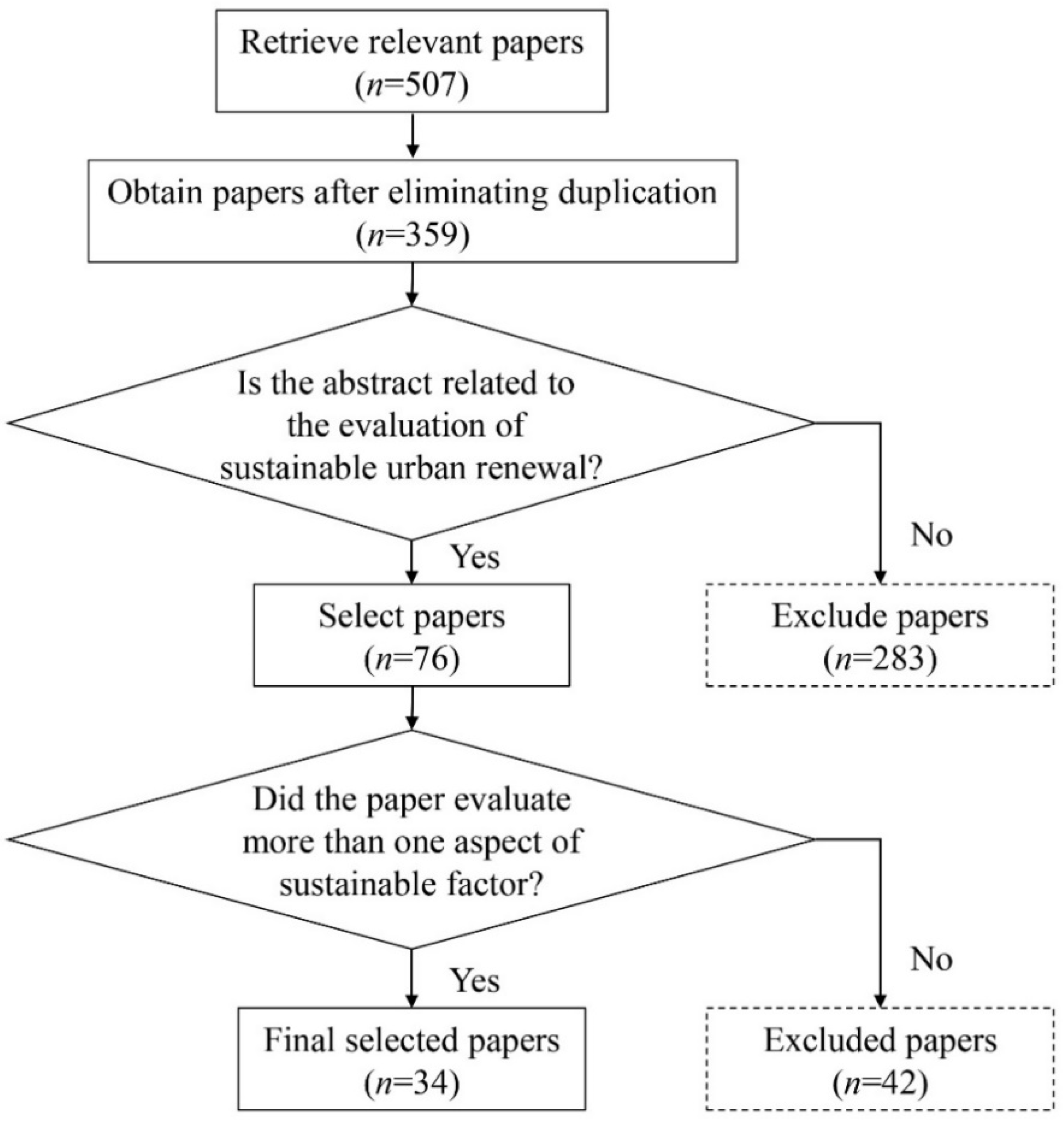
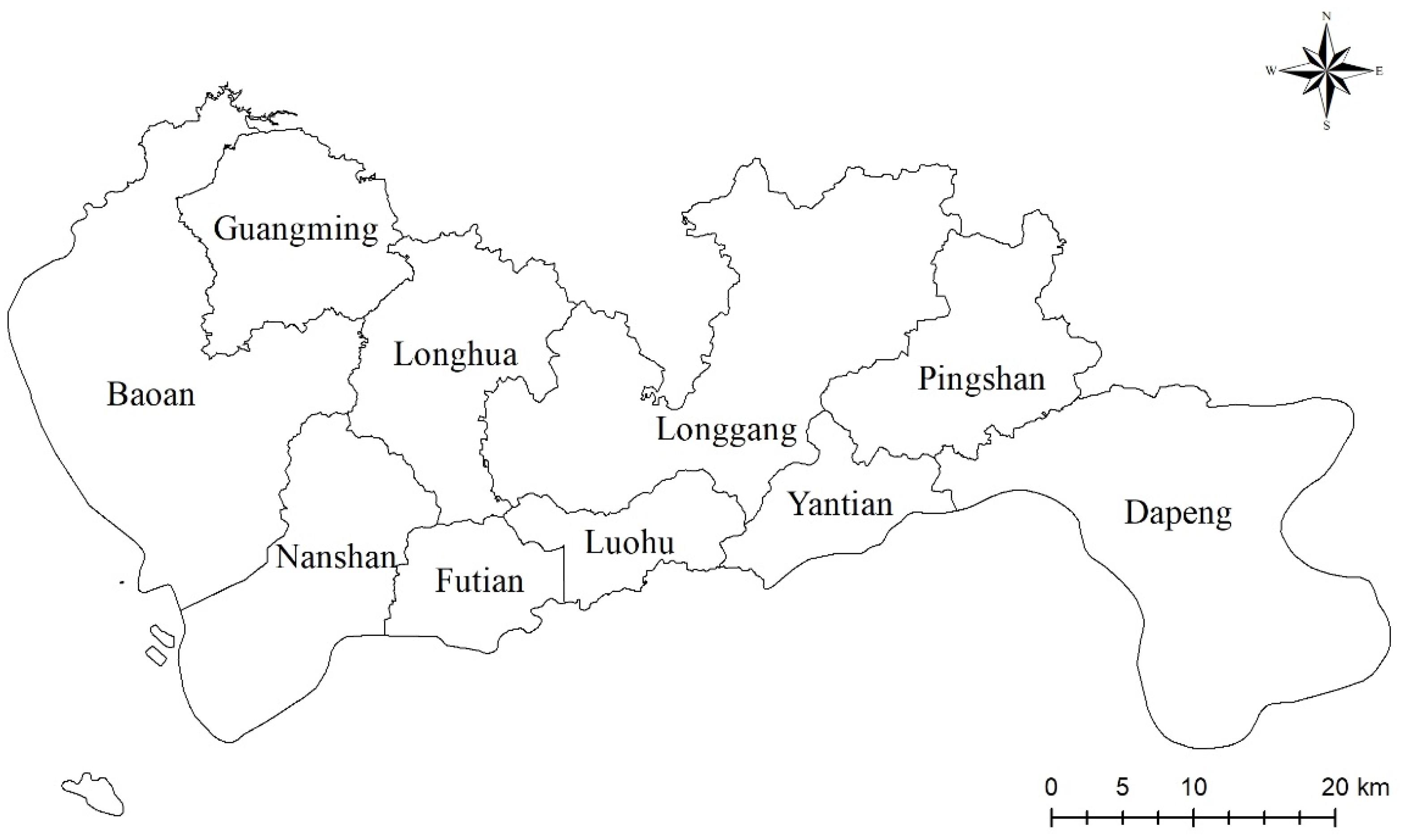
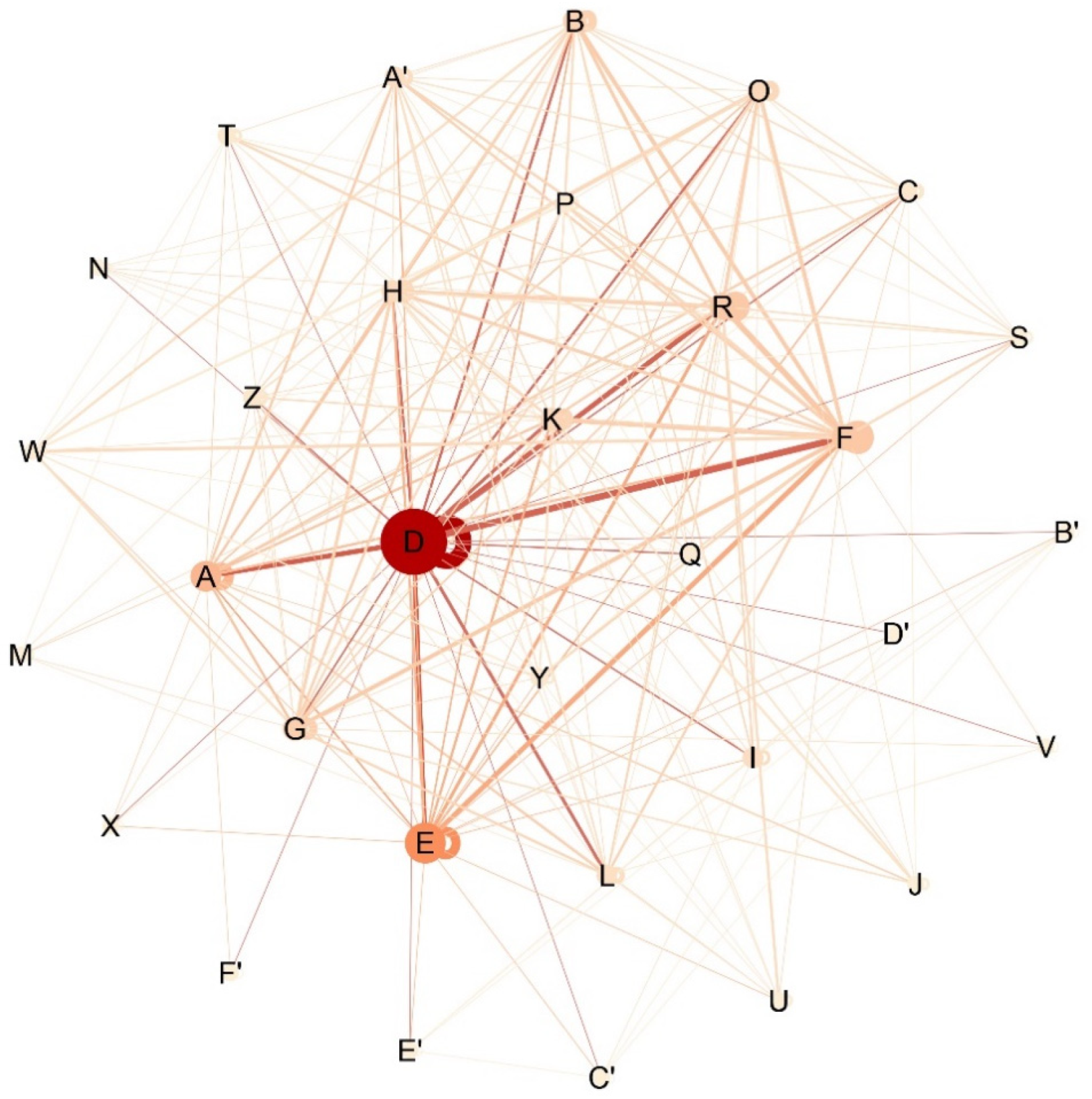
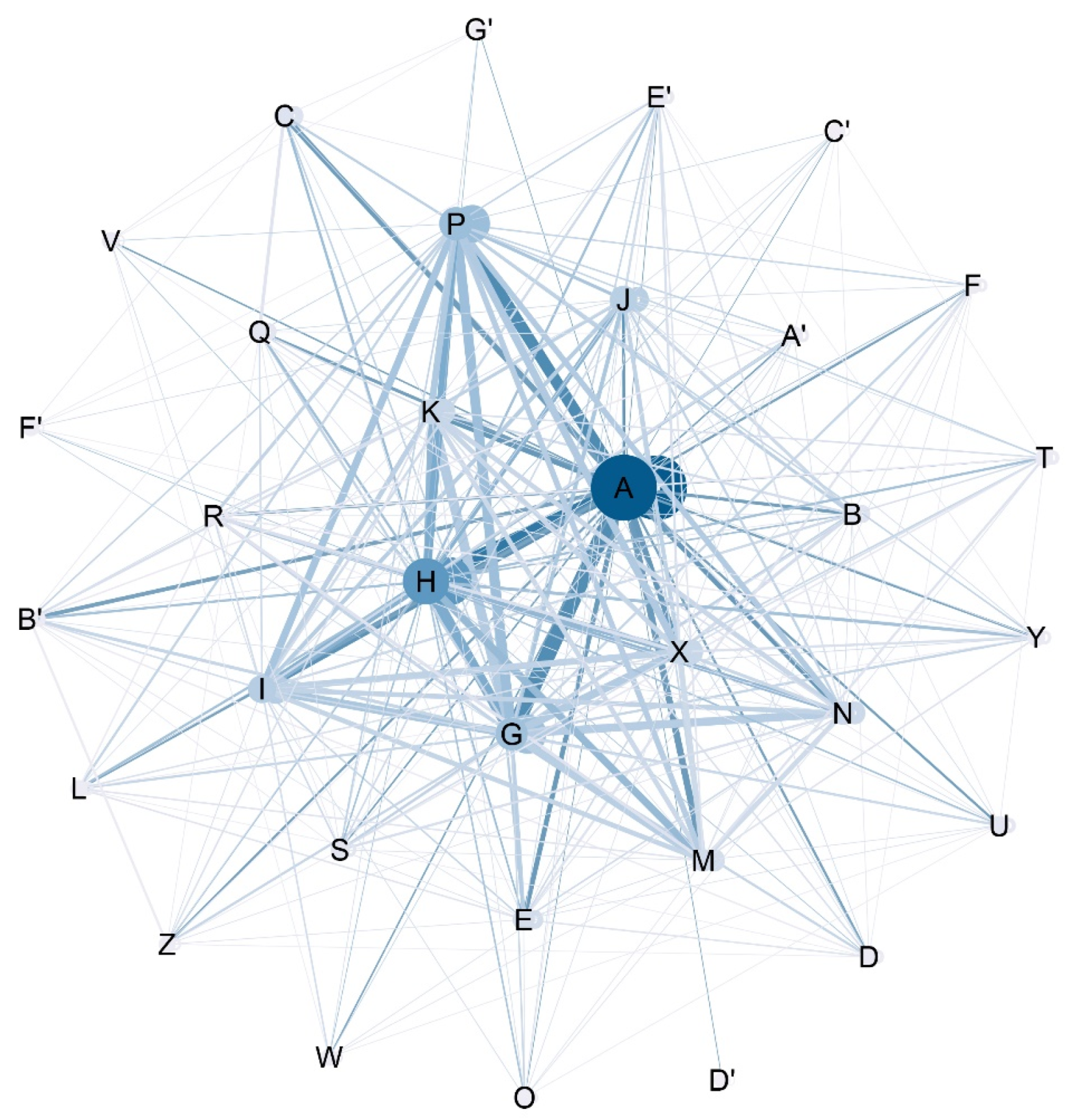

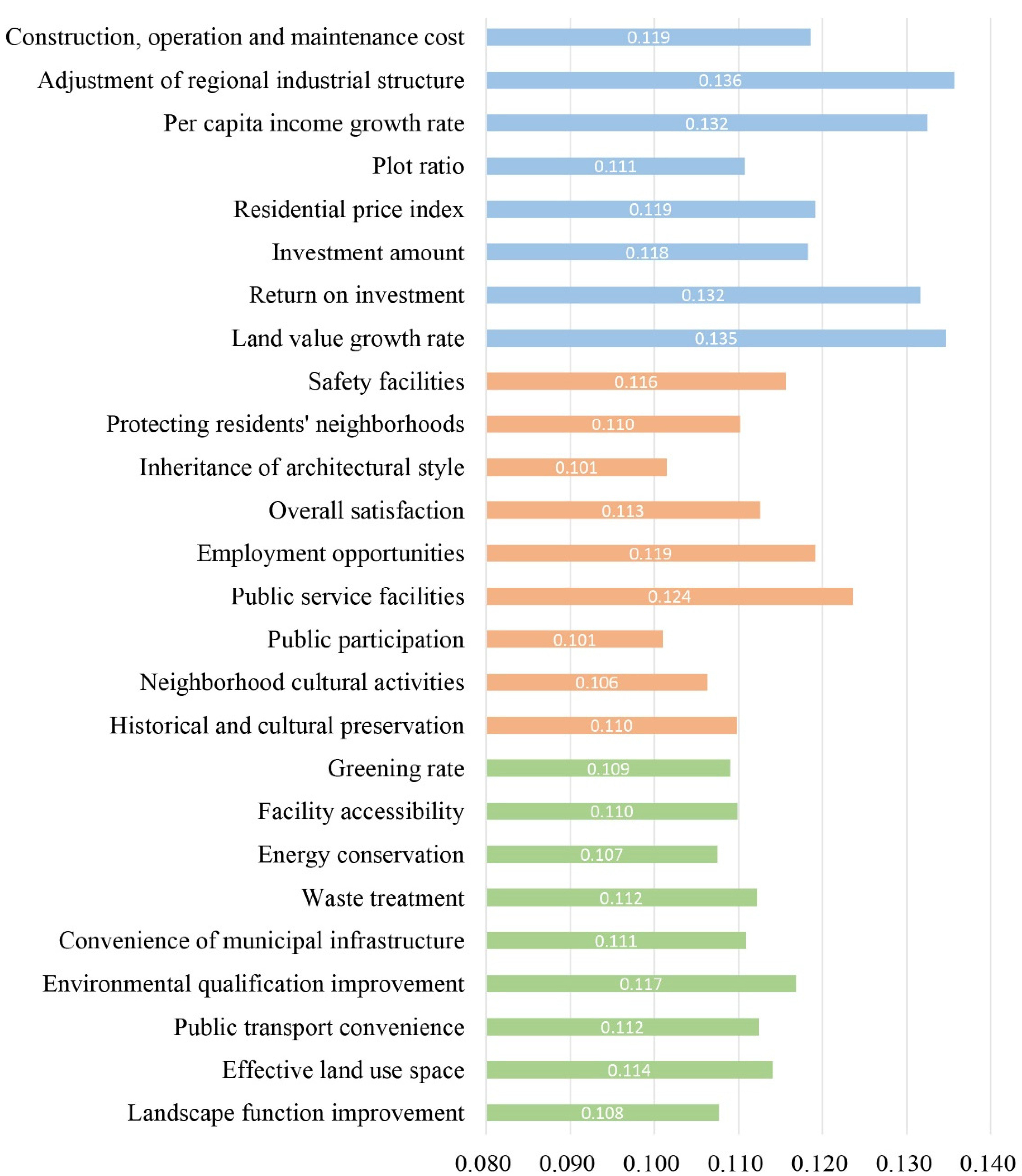
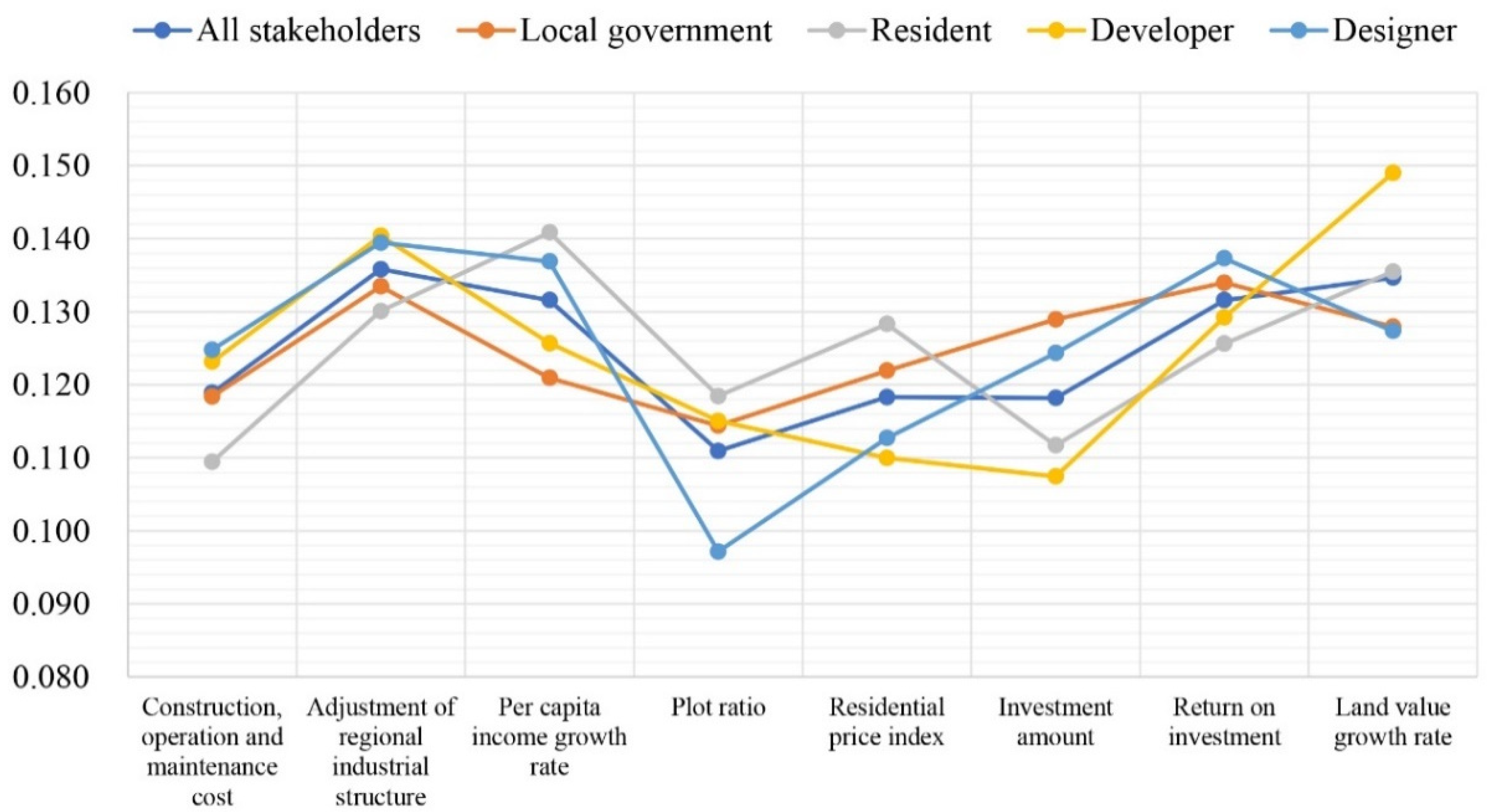
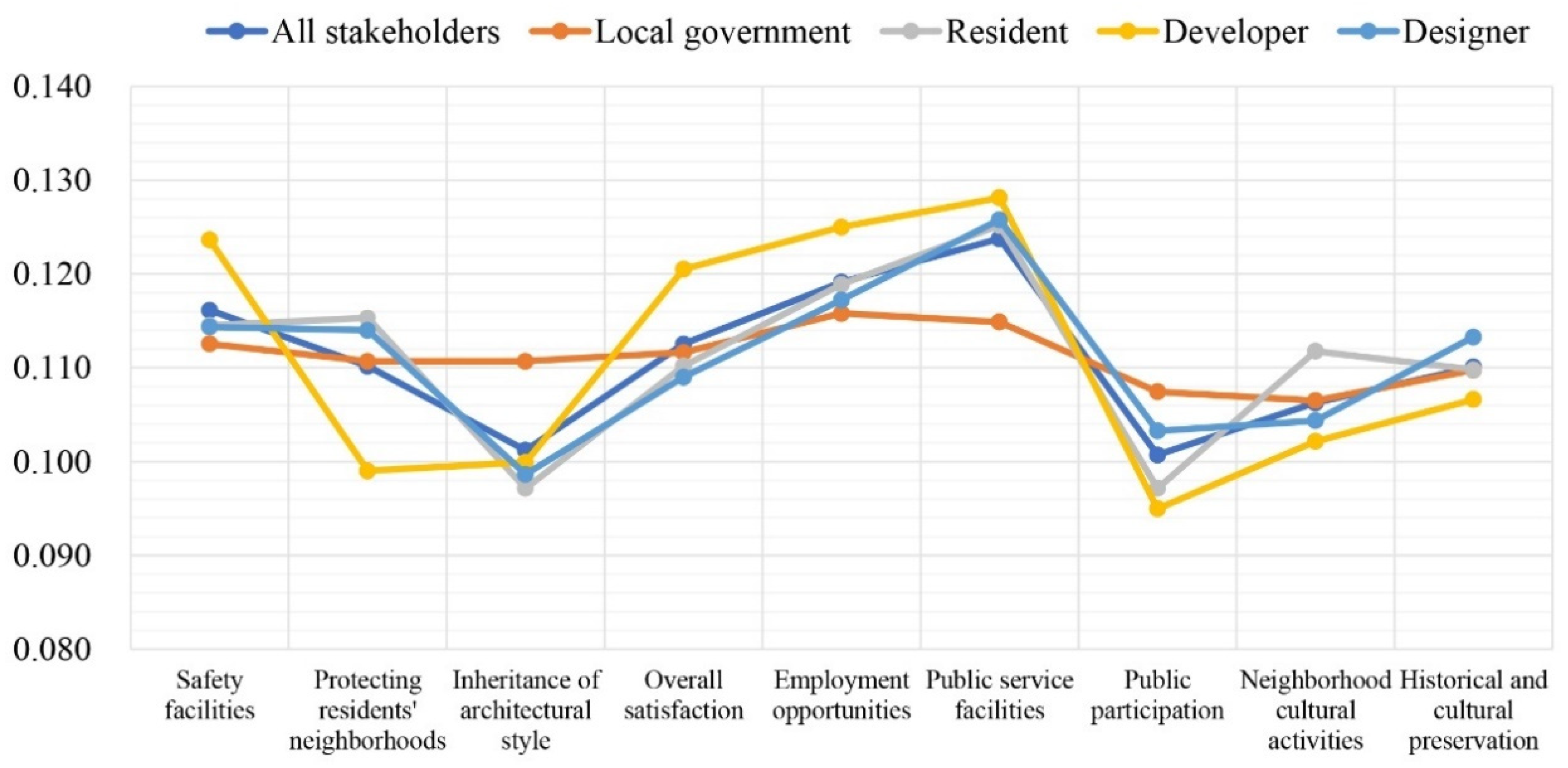
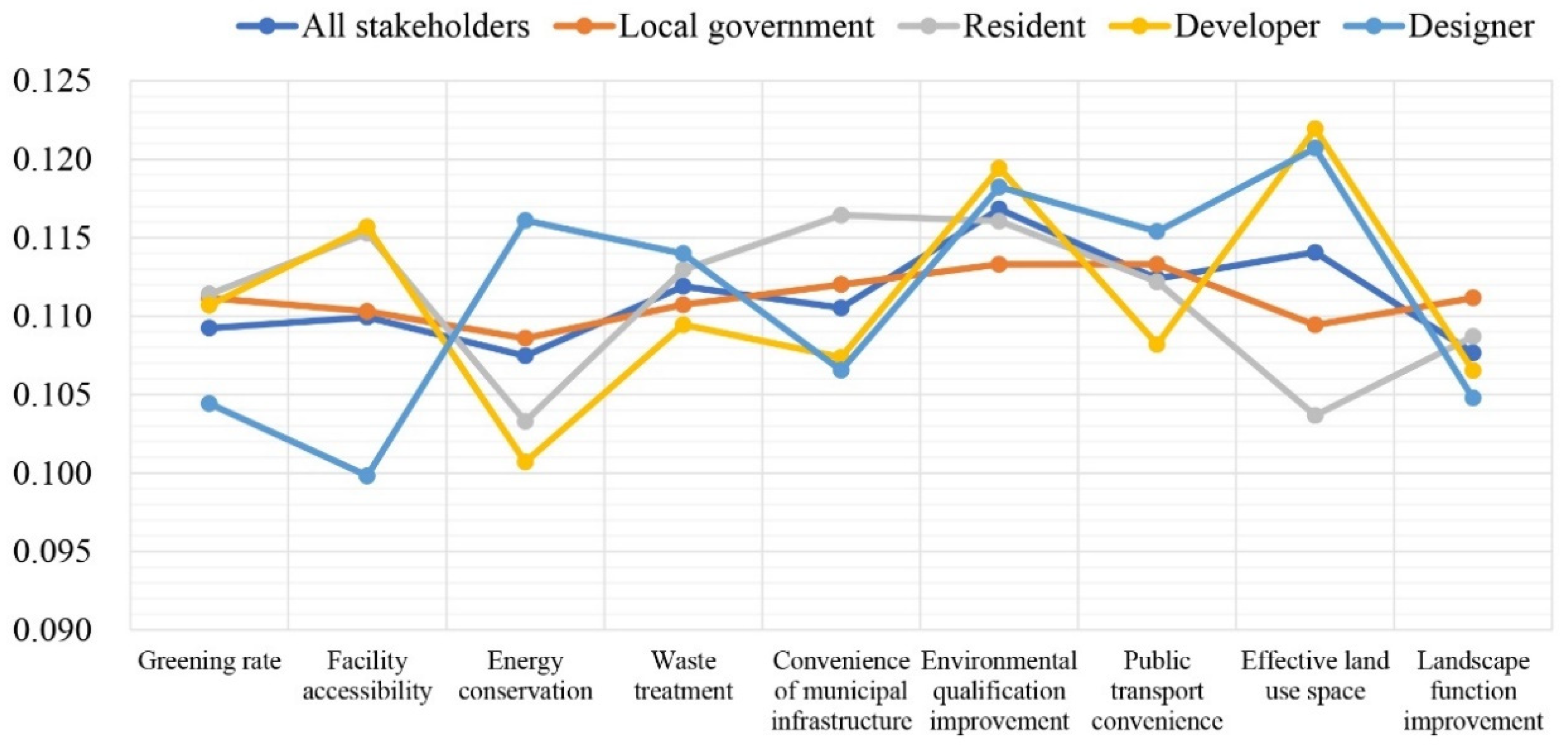
| Intensity of Importance | Definition |
|---|---|
| 0 | No importance |
| 1 | Little importance |
| 3 | Moderate importance |
| 5 | Strong importance |
| 7 | Very strong importance |
| 2, 4, 6 | Immediate values between preceding scale values |
| Attribute | Sub-Indicator |
|---|---|
| Economic | Construction, operation, and maintenance cost; |
| Adjustment of regional industrial structure; | |
| Per capita income growth rate; | |
| Plot ratio; | |
| Residential price index; | |
| Investment amount; | |
| Return on investment; | |
| Land value growth rate. | |
| Society | Safety facilities; |
| Protecting residents’ neighborhoods; | |
| Inheritance of architectural style; | |
| Overall satisfaction; | |
| Employment opportunities; | |
| Public service facilities; | |
| Public participation; | |
| Neighborhood cultural activities; | |
| Historical and cultural preservation. | |
| Environment | Greening rate; |
| Facility accessibility; | |
| Energy conservation; | |
| Waste treatment; | |
| Convenience of municipal infrastructure; | |
| Environmental qualification improvement; | |
| Public transport convenience; | |
| Effective land use space; | |
| Landscape function improvement. |
| Attribute | Sub-Indicator | Interval Grade | Grade Eigenvalue | Weight | Reliability |
|---|---|---|---|---|---|
| Economic | Construction, operation, and maintenance cost; | [3.79, 5.50] | 4.64 | 0.119 | 0.68 |
| Adjustment of regional industrial structure; | [4.47, 6.14] | 5.30 | 0.136 | 0.71 | |
| Per capita income growth rate; | [4.37, 5.91] | 5.14 | 0.132 | 0.65 | |
| Plot ratio; | [3.51, 5.15] | 4.33 | 0.111 | 0.57 | |
| Residential price index; | [3.81, 5.43] | 4.62 | 0.118 | 0.64 | |
| Investment amount; | [3.76, 5.47] | 4.61 | 0.118 | 0.68 | |
| Return on investment; | [4.32, 5.95] | 5.14 | 0.132 | 0.67 | |
| Land value growth rate. | [4.4, 6.06] | 5.26 | 0.135 | 0.65 | |
| Society | Safety facilities; | [4.42, 5.93] | 5.17 | 0.116 | 0.69 |
| Protecting residents’ neighborhoods; | [4.14, 5.68] | 4.91 | 0.110 | 0.64 | |
| Inheritance of architectural style; | [3.71, 5.31] | 4.51 | 0.101 | 0.68 | |
| Overall satisfaction; | [4.19, 5.83] | 5.01 | 0.113 | 0.74 | |
| Employment opportunities; | [4.52, 6.09] | 5.31 | 0.119 | 0.64 | |
| Public service facilities; | [4.74, 6.28] | 5.51 | 0.124 | 0.80 | |
| Public participation; | [3.68, 5.29] | 4.49 | 0.101 | 0.51 | |
| Neighborhood cultural activities; | [3.93, 5.54] | 4.73 | 0.106 | 0.67 | |
| Historical and cultural preservation. | [4.12, 5.69] | 4.90 | 0.110 | 0.67 | |
| Environment | Greening rate; | [4.31, 5.85] | 5.08 | 0.109 | 0.66 |
| Facility accessibility; | [4.35, 5.88] | 5.11 | 0.110 | 0.70 | |
| Energy conservation; | [4.26, 5.74] | 5.00 | 0.107 | 0.61 | |
| Waste treatment; | [4.44, 5.97] | 5.21 | 0.112 | 0.62 | |
| Convenience of municipal infrastructure; | [4.39, 5.90] | 5.14 | 0.111 | 0.66 | |
| Environmental qualification improvement; | [4.69, 6.18] | 5.44 | 0.117 | 0.68 | |
| Public transport convenience; | [4.46, 6.00] | 5.23 | 0.112 | 0.65 | |
| Effective land use space; | [4.55, 6.06] | 5.31 | 0.114 | 0.68 | |
| Landscape function improvement. | [4.22, 5.80] | 5.01 | 0.108 | 0.72 |
Disclaimer/Publisher’s Note: The statements, opinions and data contained in all publications are solely those of the individual author(s) and contributor(s) and not of MDPI and/or the editor(s). MDPI and/or the editor(s) disclaim responsibility for any injury to people or property resulting from any ideas, methods, instructions or products referred to in the content. |
© 2023 by the authors. Licensee MDPI, Basel, Switzerland. This article is an open access article distributed under the terms and conditions of the Creative Commons Attribution (CC BY) license (https://creativecommons.org/licenses/by/4.0/).
Share and Cite
Bai, Y.; Wu, S.; Zhang, Y. Exploring the Key Factors Influencing Sustainable Urban Renewal from the Perspective of Multiple Stakeholders. Sustainability 2023, 15, 10596. https://doi.org/10.3390/su151310596
Bai Y, Wu S, Zhang Y. Exploring the Key Factors Influencing Sustainable Urban Renewal from the Perspective of Multiple Stakeholders. Sustainability. 2023; 15(13):10596. https://doi.org/10.3390/su151310596
Chicago/Turabian StyleBai, Yunxi, Shanshan Wu, and Yunjie Zhang. 2023. "Exploring the Key Factors Influencing Sustainable Urban Renewal from the Perspective of Multiple Stakeholders" Sustainability 15, no. 13: 10596. https://doi.org/10.3390/su151310596
APA StyleBai, Y., Wu, S., & Zhang, Y. (2023). Exploring the Key Factors Influencing Sustainable Urban Renewal from the Perspective of Multiple Stakeholders. Sustainability, 15(13), 10596. https://doi.org/10.3390/su151310596






